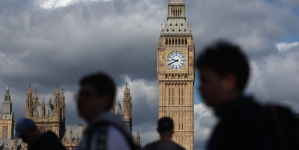-
Nvidia’s A.I. Gains Will Be in Focus Today - February 21, 2024
-
A portion of Mulholland Drive, damaged by mudslides in winter storms, reopens - May 26, 2024
-
‘Maybe You Don’t Want to Win’ - May 26, 2024
-
Donald Trump Putting Law Enforcement in Danger: Attorney - May 26, 2024
-
Avoid the waters of these 5 L.A. County beaches this holiday weekend, public health officials say - May 26, 2024
-
Bawdy Comedy ‘Anora’ Wins Palme d’Or at Cannes Film Festival - May 26, 2024
-
Map Shows Heat Wave Zone Spread Into Five New States - May 26, 2024
-
Azusa police arrest suspected slingshot-wielding vandal - May 25, 2024
-
Donald Trump Hammers Judge Ahead of Jury Instructions - May 25, 2024
-
Sometimes U.S. and U.K. Politics Seem in Lock Step. Not This Year. - May 25, 2024
Nvidia’s A.I. Gains Will Be in Focus Today
Investors brace for “fireworks”
The stock price of the chip giant Nvidia has marched steadily higher over the past year and a half, propelled by investors’ hopes that artificial intelligence is truly transformative technology — and by their hope that the company’s high-end semiconductors will continue to power that technology.
But in recent days, the company became the third most valuable listed company in the U.S., only to slump back to fifth. Its shares will face another big test on Wednesday, when Nvidia announces its latest quarterly earnings, with billions in investor capital on the line.
Brace for a huge move. After seeing the stock more than double since May on the back of huge demand for Nvidia’s chips, investors are wondering if it’s close to peaking. Opinion on Wall Street appears divided: Bloomberg reports that options traders have piled into both put options, whose value rises as a stock’s price falls, and call options. That means that Nvidia’s market capitalization could swing by some $180 billion on Wednesday.
Those bets “suggest that the post-results move is priced to be 10.5 percent in either direction, so stand by for potential fireworks across markets in either direction,” Jim Reid, a strategist at Deutsche Bank, wrote to investors on Wednesday.
That’s after Tuesday’s drop in Nvidia shares wiped out $78 billion in market value. It’s worth remembering that Nvidia has become one of the biggest components of the S&P 500, making it one of the most widely held stocks around. That dip helped pull the index into the red on Tuesday, showing Nvidia’s market-moving power.
What to watch for: Analysts have forecast that Nvidia’s fourth-quarter sales more than tripled year-on-year, and that net earnings for the year grew roughly sevenfold, on the strength of the company’s booming data center business and robust demand for its chips.
Investors will also pay attention to the year ahead outlook, given how Nvidia has been caught up in Washington-Beijing trade tensions. China had been one of the company’s fastest-growing markets, but it’s now banned from selling its highest-end chips there. Chinese rivals are seen as rapidly bridging the gap between their wares and Nvidia’s; so, too, are in-house A.I. chips being built by Amazon, Google, Meta and Microsoft.
-
The market is also focussed on the minutes from the Fed’s most recent meeting: Traders have pared back their bets on rate cuts after last week’s hotter-than-expected inflation data, and Wednesday’s release could offer new insight into when the central bank might start lowering borrowing costs.
HERE’S WHAT’S HAPPENING
President Biden’s campaign out-raises Donald Trump’s. Biden’s re-election effort had $56 million in its coffers at the end of January, compared with about $30 million for the Trump campaign. That reflects both Democratic donors appearing to unify behind the president and Trump’s growing legal costs. Separately, Attorney General Letitia James of New York said that she would consider seizing Trump’s assets if he’s unable to pay a $354 million judgment in the civil fraud case she pursued against him.
The F.T.C. and states reportedly plan to sue to block Kroger’s takeover of Albertsons. The agency and state attorneys general are preparing to challenge the $24.6 billion supermarket deal as soon as next week, according to Bloomberg. Their expected lawsuit is said to argue that a deal would lower employee wages and increase costs for consumers.
HSBC’s profits plunge after a $3 billion charge in China. Fourth-quarter profits at Europe’s biggest bank fell 80 percent after taking a write-down on its stake in the Bank of Communications and a $2 billion hit on the sale of its French retail operations. HSBC’s shares are down on Wednesday on worries that the slowdown in China, one of HSBC’s biggest markets, could hurt its business.
Harvard tries to contain another antisemitism controversy. The university’s interim president, Alan Garber, condemned a social media post circulated by two student organizations and a faculty organization featuring what he called “vile and hateful antisemitic tropes.” The groups later disavowed the cartoon, but the episode is the latest controversy at Harvard after the Hamas-led Oct. 7 attacks on Israel.
Foes come out strong against Capital One’s big deal
Capital One’s $35.3 billion deal to buy Discover Financial was always going to be a tricky one to get past financial regulators, since it would lead to the creation of a new credit card giant.
Public opposition to the transaction is already proving strong, as consumer advocates worry about combining two major lenders.
The companies’ C.E.O.s acknowledged that regulators could be skeptical. On an analyst call on Tuesday, Richard Fairbank, Capital One’s chief, alluded to becoming a stronger competitor to both larger banks and Visa and Mastercard, the nation’s biggest payment network operators:
-
“The enhanced scale and reach of our combined franchise will position us to compete more effectively against some of the largest banks and payment companies in the United States.”
-
“There are only two vertically integrated U.S.-based payments networks, American Express and Discover, and they compete with Visa and Mastercard, who are, of course, much larger.”
Worth noting: A combined Capital One and Discover would surpass JPMorgan Chase as the nation’s biggest credit card issuer, according to one estimate, and the lender is expected to move some of those cards to Discover’s payment network.
Otherwise, Fairbank had little to say about potential snags. He told analysts: “We believe that we are well positioned for approval, but of course, we can’t discuss our conversations with our regulators. We, of course, kept them informed along the way in the process.”
Critics of the deal didn’t seem assuaged by Capital One’s arguments, pointing to data points like a recent report by the Consumer Financial Protection Bureau that showed larger issuers (like Capital One) charging borrowers more than smaller rivals.
-
“This Wall street deal is dangerous and will harm working people,” Senator Elizabeth Warren, Democrat of Massachusetts, posted on the social network X on Tuesday. “Regulators must block it immediately.”
-
“Capital One has a pattern of making deals that benefit the bank, but not customers and communities,” Jesse Van Tol, the C.E.O. of the National Community Reinvestment Coalition, said in a statement.
The Justice Department hasn’t said anything publicly, and won’t be the primary regulator looking at the Capital One deal (but will get to weigh in). Still, bank watchers have pointed DealBook to a speech last year by Jonathan Kanter, the department’s antitrust chief, calling bank competition “essential” and arguing that reviewing such deals requires acknowledging “modern market realities.”
D.E.I. in the headlights
The fate of corporate diversity efforts had already looked cloudy after the Supreme Court last year rejected affirmative action as a factor in U.S. college admissions. Now, a rare action by an appeals court to rehear a challenge to Nasdaq’s move to increase board diversity raises new questions about whether the exchange’s initiative can survive.
Nasdaq wants more board diversity data than the law requires. In 2020, the exchange asked the S.E.C. to approve a rule that would require thousands of companies listed on its exchange to disclose information about their boards’ makeup, or face delisting. The S.E.C. later approved it.
Two groups challenged the rule in court, losing before a panel of the U.S. Court of Appeals for the Fifth Circuit in October. Among the plaintiffs was a group founded by Edward Blum, a conservative activist also behind another organization that brought the lawsuits that led to the Supreme Court’s affirmative action ruling.
But the Fifth Circuit on Monday agreed to reconsider the challenge en banc, with all of its judges set to review the matter after a hearing scheduled for May. The court has a reputation for being more willing to entertain, and approve, unusual legal theories.
Nasdaq declined to comment, while an S.E.C. spokeswoman said the agency would continue to defend its actions. Blum didn’t respond to a request for comment.
It’s getting harder for companies to understand the shifting landscape. Republican state attorneys general have threatened companies that adopt diversity initiatives, and businesses have struggled to figure out the legality of their programs.
That wariness is being reflected in sometimes unexpected ways: At a webinar on Tuesday hosted by the Aspen Institute Business and Society Program about the future of such initiatives, speakers insisted on not being named or quoted.
Putting a number on strikes’ impact
The Labor Department on Wednesday will release its first measure of the “year of the strike” on American business, including disruptive work stoppages by large unions like SAG-AFTRA and the U.A.W.
But labor experts say that it will almost certainly undercount the effect, because the data won’t reflect the emerging trend of organizing smaller workplaces.
Smaller walkouts are a big deal, too. The Labor Action Tracker by researchers at Cornell and the University of Illinois Urbana-Champaign show that there were 470 stoppages and lockouts last year, amounting to nearly 25 million strike days. The hotel and food industry accounted for the largest share of stoppages that the research tracks, but the smallest share of workers who walked out.
But Wednesday’s Labor Department data will most likely underestimate that impact, because it won’t include stoppages involving fewer than 1,000 workers. That disparity has shown up before: The Labor Department counted 23 strikes in 2022, while Labor Action tallied 433.
Unions see a need to get a foothold in smaller workplaces, including at units of larger companies like Starbucks. “Due to the growth in employment in smaller establishments, for unions to be successful in representing workers, they need to be able to organize these smaller workplaces,” Alex Colvin, the dean of Cornell’s School of Industrial and Labor Relations, told DealBook.
Changing tactics are another focus of labor watchers. One-day walkouts are on the rise, Colvin said. And the U.A.W. introduced a wrinkle when it organized stoppages at select plants rather than an across-the-board walkout, a strategy that kept management guessing and helped the union target the Big Three automakers for longer. That helped it win big in negotiations.































